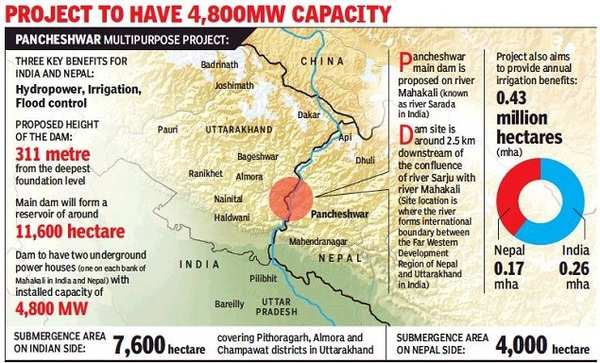PANCHESHWAR MULTIPURPOSE PROJECT

The Pancheshwar Multipurpose Project (PMP) is a significant infrastructure initiative proposed for development in the Mahakali River basin, situated in the Far Western Development Region of Nepal. Here are key details about the project:
-
Location: The project is located upstream from the proposed Pancheshwar High Dam site, covering parts of Darchula, Baitadi, and Dadeldhura districts in Nepal. The geographical coordinates range from 29° 07' 30" to 29° 48' North latitude and 79° 55' to 80° 35' East longitude.
-
Drainage Area: The Mahakali River basin, where the project is situated, has a drainage area of 12,100 square kilometers.
-
Power Generation: The primary objective of the Pancheshwar Multipurpose Project is to harness the hydropower potential of the Mahakali River. The project aims to generate a substantial peak power capacity of 6,720 MW. This includes 6,480 MW from the Pancheshwar High Dam and an additional 240 MW from the Rupali Gad Re-regulating Dam.
-
Annual Energy Production: The project anticipates an annual average energy production of 12,333 gigawatt-hours (GWh), contributing significantly to the region's power supply.
-
Alternative Power Generation: The Poornagiri re-regulating dam is identified as an alternative to the Rupali Gad Re-regulating Dam within the project. This alternative is expected to generate an additional 1,000 MW of power.
-
Geopolitical Context: The project area is strategically positioned along the Nepal-India border, and at present, the site can be accessed primarily through India. However, an alternative access route through Nepal involves a two-day trek from Patan, Baitadi
The Pancheshwar Multipurpose Project (PMP) holds significant importance for various reasons:
- One of the primary objectives of the PMP is to harness the hydropower potential of the Mahakali River. With a proposed peak power capacity of 6,720 MW, including the Pancheshwar High Dam and associated structures, the project contributes significantly to addressing the energy needs of the region. This electricity generation is crucial for meeting the increasing demand for power in Nepal and potentially supporting the energy requirements of neighboring regions
- The generation of electricity from the PMP is expected to stimulate economic development in the Far Western Development Region of Nepal. Access to a reliable and abundant power supply can attract industries, create job opportunities, and boost overall economic growth in the region
- The project involves the construction of dams and reservoirs, allowing for better management of water resources in the Mahakali River basin. The multipurpose nature of the project facilitates water storage, flood control, and irrigation, thereby enhancing agricultural productivity and supporting water-dependent sectors
- The project is situated along the Nepal-India border, and its development involves collaboration between the two countries. This cross-border cooperation fosters diplomatic and economic ties, promoting shared benefits and mutual interests
- The construction of dams, powerhouses, and associated infrastructure for the PMP contributes to the overall development of critical infrastructure in the region. This includes roads, transmission lines, and other facilities necessary for the project, which can also be utilized for broader connectivity and development initiatives
- Hydropower projects like PMP are considered cleaner and more environmentally friendly compared to fossil fuel-based power generation. By promoting the use of renewable energy, the project contributes to efforts aimed at mitigating the impact of climate change
- The project's reservoirs and dams play a role in managing water flow, providing flood control benefits to downstream areas. Additionally, controlled release of water can be utilized for irrigation purposes, enhancing agricultural activities and food security in the region
4.Mahakali River
The Mahakali River, also known as the Kali River, is a transboundary river flowing through India and Nepal.
Here are some key details about the Mahakali River:
- The Mahakali River originates in the high mountains of the Himalayas in the Pithoragarh district of Uttarakhand, India. It then flows through the western part of Nepal, forming a natural boundary between India and Nepal
- The Mahakali River serves as a natural boundary between India and Nepal for a significant stretch of its course. It is an essential part of the geopolitical landscape between the two countries
- The river is fed by numerous tributaries as it flows through the Himalayan region. Some of the major tributaries include the Dhauliganga, Kuthi Yankti, Saryu, and Ramganga rivers
- The Mahakali River is the proposed site for the Pancheshwar Multipurpose Project (PMP), a significant hydropower project aimed at harnessing the river's water resources for electricity generation, flood control, and irrigation
- The Mahakali River basin is known for its significant hydropower potential. The Pancheshwar Multipurpose Project, with its planned capacity of 6,720 MW, is one of the initiatives aimed at tapping into this potential to meet the growing energy demands of the region
- The river holds cultural and historical significance in the region. It is mentioned in ancient Hindu scriptures, and the areas along its course have historical and cultural connections with local communities
- The Mahakali River basin is characterized by rich biodiversity, with diverse flora and fauna. The river and its surroundings support various ecosystems and provide habitats for numerous species
- The river plays a crucial role in supporting local economies through fishing and agriculture. Communities along its banks often rely on the river's resources for their livelihoods
- The scenic beauty of the Mahakali River and its surroundings attracts tourists and adventure enthusiasts. The river offers opportunities for activities like white-water rafting and trekking in the picturesque Himalayan landscape




